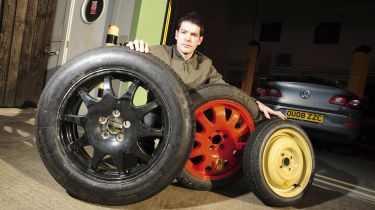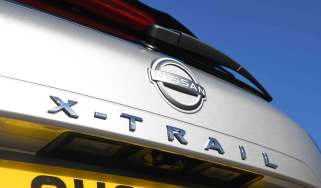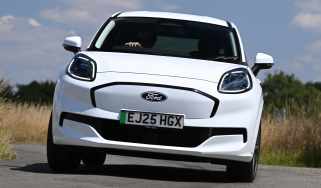Are space-savers safe?
Traditional spare tyres are becoming a thing of the past – but can you rely on the skinny rubber in your car’s boot? We put it to the test...
If you look in your car’s boot, you’re as likely to find a skinny space-saving wheel as a full-size spare. But if you fit one of these temporary tyres and then forget it’s there – or are simply too lazy to arrange a replacement – it could prove fatal.
Tyre fitters have complained before to Auto Express that it’s not uncommon to find worn-out space-savers on some reckless motorists’ cars – conclusive proof that the tyres are being driven further than their advised 50-mile limit.
In 2000, a group of youngsters was killed in a crash in east London as their space-saver couldn’t handle an emergency manoeuvre. So, drivers ignore these tyres’ limitations at their peril. However, the introduction of an all-new space-saver, with a higher 80mph speed rating, looks set to shake up the industry. While European law forbids you from driving at more than 50mph on any temporary spare, whatever the claimed limit, this higher-speed capability should make the new version a safer option. Auto Express decided to find out.
We put the new product to the test in a head-to-head with a 50mph spare, plus two other puncture repair solutions. We looked at grip and how each tyre affected a car’s handling in an emergency – and were shocked by the results. Whereas the 50mph version provided seven per cent less grip, the 80mph variant was no worse than a standard tyre – and in some instances stuck to the road better!
How we did it
To do the tests, we went to the Motor Industry Research Association (MIRA)proving grounds in Warwickshire with four cars, each fitted with a different tyre set-up. Our Subaru Justy came with a 50mph space-saver, a Renault Laguna had the new 80mph tyre, a MINI Clubman featured run-flats and a VW Passat CC was fitted with new self-sealing rubber.
We drove each model on its standard tyres and then with its replacements. Behind the wheel was Auto Express road tester and in-house racing driver, Owen Mildenhall, plus consumer editor and tyre guru Kim Adams. Between them, they took each car on a timed lap around a soaking wet circle with a 56-metre radius, in order to measure grip – you can see the results on Page 36. The pair then subjected the vehicles to a high-speed lane change to replicate an emergency manoeuvre on the motorway. Each car was driven on standard tyres, then with the alternative rubber on the front and then on the rear. Here are our findings:
50mph space-saver
First to be tested was the space-saver on our long-term Subaru Justy. This skinny, lightweight wheel is designed to help the car limp to the nearest garage at a maximum of 50mph. It’s also found in the boot of one-third of all new models, as our investigation in Issue 982 revealed. At 6cm thinner than the standard wheel, it looked less grippy. We tried the standard tyres first, heading towards a cone barrier at 50mph. The manoeuvre was a white-knuckle ride; but when we switched the front left wheel to the space-saver, the car fish-tailed in both directions.
When we tried the run with the space-saver on the rear, even expert road tester Owen couldn’t stop the Justy spinning through 180 degrees. We then attempted the lane change at a reckless 65mph: the Subaru made it through, but only an expert driver with several practice runs under his belt could have done it.
As our results reveal, the loss of grip was reflected by the Justy’s wet circle lap time. With the space-saver on the front left, it took 31.21 seconds – two seconds slower than with the standard rubber.
80mph space-saver
At 6cm wider than the Justy’s 50mph space-saver, the Laguna’s 80mph version certainly looks more substantial. Maker Continental says its construction is also stiffer, to allow it to cope with the Renault’s greater mass and handle higher speeds.
And, around the circle, the substitute tyre actually had more grip than our long- term Laguna’s standard rubber! When fitted to the front corner, the family car was half-a-second quicker around the circle. During the emergency lane change, it was totally unflustered with its space-saver on either end – even when we broke the tyre’s 50mph limit and hit 70mph!
Expert Kim said the increased grip was partly due to the fact that the space-saver was brand new, while the rest of the tyres on our Laguna had done 15,000 miles. But he added: “While the 80mph space-saver would have slightly less grip than standard in the dry – hence its speed limit – it’s still a better option than the 50mph tyre.
“Small space-savers are fine within their limits. But people often don’t keep under the advised speed, and don’t use them as temporary measures. Exceed the rim’s parameters and you’re in trouble.”
What baffled us, however, was why the space-saver carries an 80mph sticker, when EU law says motorists are allowed to use it only up to 50mph. Could this mislead Laguna owners? Renault admitted it had made a mistake. A spokesman said: “The wheel is safe up to 80mph, but people need to respect the law. We’ll add a sticker explaining this.”
Run-flats
While the new space-saver might be the best spare wheel option, not all cars have room to store one in the boot. Another alternative is the run-flat rubber fitted to five per cent of modern cars in the UK – including most of BMW’s models.
Stiffened-sidewall technology means they can be driven with a puncture for up to 50 miles, at 50mph. A major benefit is that you don’t have to change the wheel after a puncture. All vehicles with these tyres have a pressure monitoring system to warn you when you have a problem, so you can head to the nearest garage. The only downside is that a run-flat can’t be repaired, so the driver has to pay for a replacement. This can cost hundreds of pounds as run-flats are generally 15 per cent pricier than standard tyres.
Taking our MINI Clubman through the emergency lane change at 50mph on its run-flats was straightforward. But when we tried it with the rubber deflated at the front or rear left corner, the car suffered a 10 per cent loss of grip. To mimic a reckless driver, we did it again, at 65mph. To turn the MINI here, Owen had to be much more aggressive in his control, and although the vehicle was still capable of handling the manoeuvre, it was more difficult to keep in check.
Interestingly, it was the run-flat tyre that suffered the biggest loss of grip on the wet circle. With the rubber deflated on the front corner, the car took an extra 2.78 seconds to get round the lap. But Owen didn’t believe this meant the tyres were more dangerous. He said: “The advantage of run-flats is that you always know when you have a puncture. That sponginess reminds you not to exceed the limits. The grip is lost progressively, so drivers are less likely to be caught out.”
He added that, unlike a standard tyre, run-flats won’t collapse and peel off the wheel in a blow-out. If this happens on the motorway, the driver can be in serious trouble with only three wheels gripping the road. Owen explained: “When a normal tyre deflates it loses hold of the rim and can come off. A run-flat has super-rigid sidewalls which don’t let go of the wheel, so the tyre stays in place.”
ContiSeal
Our final test was on Continental’s new system, ContiSeal. The maker claims you can pierce the rubber with an object of up to 5mm wide, and it will stay inflated. This means you don’t even need a spare wheel! And unlike run-flats, there is no loss in ride quality or restriction to the speed or distance the car can be driven with a puncture. The tyres are a similar cost to stiffened sidewall rubber, too.
Sure enough, when we drove our VW Passat CC over a nail the tyre suffered no loss of pressure. According to Continental product manager Pete Robb, the technology involves coating the inside of a standard tyre with a hi-tech sticky substance. When pierced, the material seals around the object; if this is removed, it closes over the hole so the tyre does not deflate.
What’s more, the rubber can be repaired once the object has been taken out. But Robb admitted that the system would not protect against damage to a tyre’s sidewall – if this happened, the driver would be stranded by the roadside and have to call a breakdown patrol. Given that there was no difference in pressure when the Passat’s tyre was punctured, we did not carry out tests before and after piercing, as there would have been no variation in grip levels.
The Verdict
Our tests provided a clear winner: motorists won’t come unstuck with the higher-rated, 80mph space-saver fitted to our long-term Renault Laguna.
Compare that to the standard version, which gave our Subaru Justy problems even at 50mph. It’s a real shame, then, that the new space-saver is currently available only on the French family car. More manufacturers should urgently consider switching to this more advanced, safer technology. Where there is no room in the boot, our favourite solution was the run-flat rubber. Even though it’s limited to 50mph for 50 miles, in the event of a puncture this tyre warns of deflation, while grip loss is progressive. Plus, it won’t
come off the rim in a blow-out.
However, if you do drive on a deflated run-flat, you have to replace the tyre afterwards – and that could cost hundreds. At least with a space-saver you can get the puncture repaired cheaply if the tyre isn’t too badly damaged. Systems such as foam sealants – which come with around 16 per cent of new cars – and ContiSeal work fine, as long as there is no catastrophic failure of the tyre. If the hole is too big to be sealed, though, you will be left stranded.
Find a car with the experts



